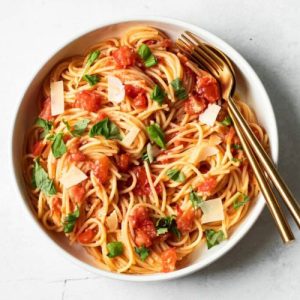
Fresh Tomato Pasta
A quick and delicious Fresh Tomato Pasta that highlights the natural flavor of ripe tomatoes. Tossed with garlic, shallots, olive oil, and fresh basil, and finished with parmesan, it’s a fiber-rich, protein-friendly, and satisfying meal perfect for weeknights or simple meal prep.
Equipment
- 1 Large Non-Stick Skillet
- 1 pot for pasta
- 1 Cutting board
- 1 knife
- Measuring
- Grater (for garlic and parmesan)
Ingredients
- 12 ounces spaghetti or preferred pasta
- 1 teaspoon olive oil
- 1 clove garlic grated
- 1 shallot finely minced
- 1½ pounds ripe tomatoes diced
- 2 teaspoons balsamic vinegar
- ½ teaspoon fine sea salt
- ⅓ cup parmesan cheese grated
- 1 cup fresh basil sliced
Instructions
- Pasta Preparation: Start by bringing a large pot of salted water to a rolling boil over high heat. Once boiling, add 12 ounces of your preferred pasta—spaghetti works beautifully, but any long or short pasta will do. Cook according to the package instructions until al dente, meaning the pasta is tender but still has a slight bite. While the pasta cooks, carefully reserve 1 cup of the starchy pasta water before draining, then set it aside. Drain the remaining pasta and place it in a large mixing bowl for later use.
- Garlic and Shallot Sauté: Place a large non-stick skillet over medium heat and pour in 1 teaspoon of olive oil. Allow the oil to warm until it shimmers gently, which should take about 30 seconds. Add 1 clove of grated garlic and 1 finely minced shallot to the skillet. Stir constantly and sauté for 1–2 minutes, or until the shallots soften and the garlic becomes fragrant. Be careful not to let the garlic brown, as it can turn bitter. This stage builds the aromatic foundation for the sauce.
- Tomato Cooking: Add 1½ pounds of diced ripe tomatoes to the skillet. Sprinkle in ½ teaspoon of fine sea salt and 2 teaspoons of balsamic vinegar. Stir gently to combine. Allow the tomatoes to cook over medium heat for 3–5 minutes. As they cook, they will start to release their natural juices, creating a light, fresh sauce. Stir occasionally, gently mashing some of the tomatoes with your spatula to help the sauce thicken while still keeping chunks for texture.
- Combining Pasta and Sauce: Once the tomatoes are soft and saucy, transfer the drained pasta into the skillet with the tomatoes. Using tongs or a large spoon, gently toss the pasta with the sauce until each strand or piece is evenly coated. If the tomatoes are on the drier side, gradually add the reserved pasta water a little at a time, stirring to create a silky, cohesive sauce that clings to the pasta. Taste at this stage and adjust salt if needed.
- Cheese and Basil Integration: Turn off the heat and sprinkle ⅓ cup of freshly grated parmesan cheese over the pasta. Stir gently, allowing the heat from the pasta and sauce to melt the cheese into a creamy coating. Then, add 1 cup of fresh basil, thinly sliced, and fold it in carefully to distribute the flavor without bruising the leaves. This final touch adds freshness, aroma, and a hint of natural sweetness.
- Plating and Garnishing: Scoop the pasta into serving bowls or onto plates, making sure each portion has a generous mix of tomatoes, cheese, and basil. For an extra flourish, sprinkle additional parmesan on top and, if desired, add a dash of freshly cracked black pepper or red pepper flakes for a subtle kick. Serve immediately while hot, allowing the pasta’s vibrant flavors and comforting warmth to shine.
- Storage and Serving Tips: This pasta is best enjoyed fresh, but leftovers can be stored in an airtight container in the refrigerator for up to 2 days. To reheat, gently warm in a skillet with a splash of water or olive oil to restore the sauce’s silky texture. Pair with a side salad or garlic bread for a complete, satisfying meal.
Notes
- Use the ripest tomatoes available for the most flavorful sauce; heirloom tomatoes or cherry tomatoes work beautifully.
- Adjust the amount of pasta water to achieve your desired sauce consistency. Juicier tomatoes may need little to no water.
- Garlic and shallots should be sautéed gently to avoid burning and bitterness.
- You can leave tomato skins on for convenience, but peeling them creates a smoother sauce.
- Fresh basil adds brightness—add it at the end to preserve flavor and color.
- Optional garnishes include freshly cracked black pepper, red pepper flakes, or extra parmesan.